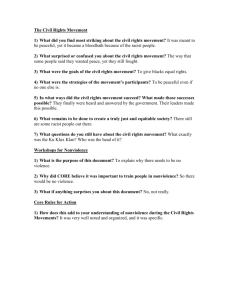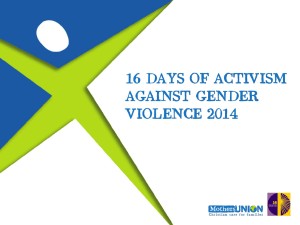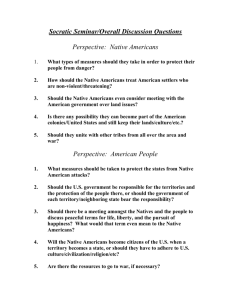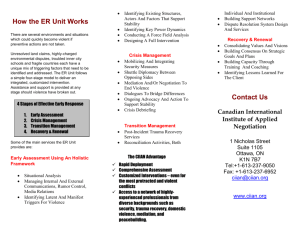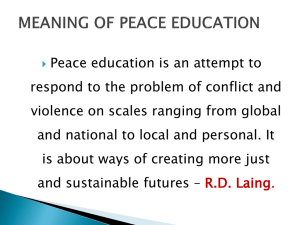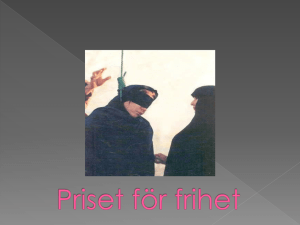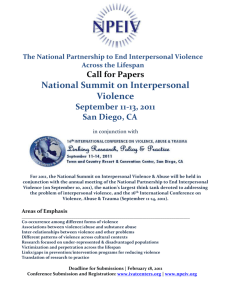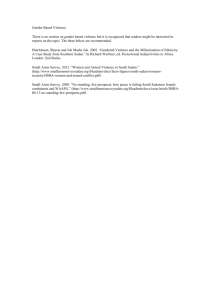Peace and Conflict Studies - Canadian Centres for Teaching Peace
advertisement
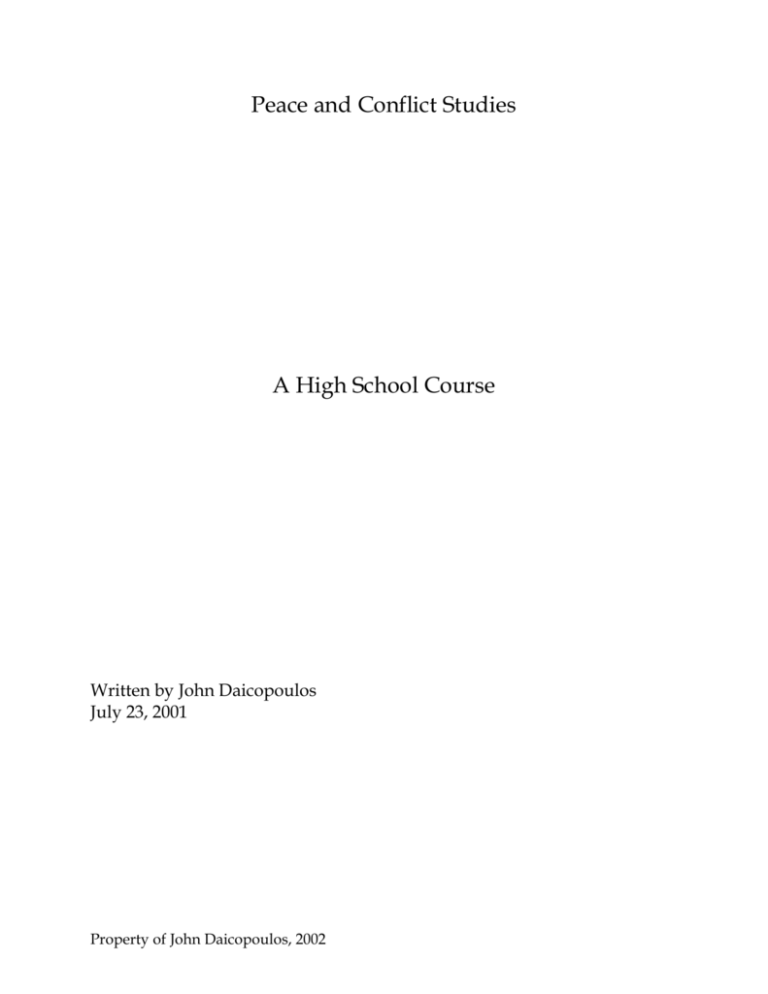
Peace and Conflict Studies A High School Course Written by John Daicopoulos July 23, 2001 Property of John Daicopoulos, 2002 Overview There can be no doubt that conflict is a natural activity of humans. It is commonly the result of contrasting ideas, perceptions, and interests over similar needs or limited resources. It is interdisciplinary, covering such diverse issues as: environmental concerns, human security, scientific debates, family ties, and political ideologies. With the ascent of technology it has also become a potentially globally destructive force. Whether as individuals or when acting in groups, our interpersonal, inter-group, and international relationships influence how we manage and cope with conflict; but individuals act differently depending on the context of their relationships. This course is designed to provide students with a greater awareness of that context and the means to function within it. Strands De-constructing Conflict. This unit covers the multi-faceted nature of conflict. It begins with a student directed process of defining and analyzing the assumptions, sources, and types of interpersonal, inter-group, and international conflict. Then, through an examination of the physiological and psychological character of individuals, students shall begin to comprehend the various theories of the roots of individual violence and its relation to interpersonal conflict. The image of war has transformed over history. Globally destructive conflicts arise when nations go to war with an industrialized military. The role of technology and its implications for “total war” is investigated. Identity and Conflict. Everyone must deal with the influence and approval of their peers. Adolescent students are not immune from this potentially harmful source of conflict. The role of individual and group identity and how they relate to the notions of peer pressure, stereotyping, and in-group/out-group characteristics is investigated. The influence of conformity and the obedience of individuals to destructive authority is analyzed through multiple theories; and how all of these influences on individuals grow to destructive levels with the ideas of race, ethnicity, religion, and nationalism. Conflict Resolution. Through a variety of role play scenarios, students will study and practice many forms of non-violent conflict resolution, including interest-based negotiation and mediation between individuals and groups, political protests, economic sanctions, and boycotts. The strengths and weaknesses of each method will be appraised through a study of the strategies involved and past successes. Analysis will involve historical situations where each method was used and why some individuals choose violent means as a solution. Building Peaceful Societies. Conflicts cause severe, and often long lasting, injury to individual relationships and social systems. Building peace requires a study of what the needs of societies or individuals are after a traumatic or violent conflict. Interpersonal needs for safety and security ascend to international standards for institutional systems and organizations to promote and sustain individual needs. Building peace requires as much work as creating war and conflict. DE-CONSTRUCTING CONFLICT OVERALL EXPECTATIONS By the end of this course, students will: • analyze the many facets of conflict and how it plays a significant role in their daily lives; • demonstrate an understanding of how and why individuals use violence and aggression to achieve their individual goals; • develop a comprehension of how the causes of regional and international wars and conflicts have changed over history; SPECIFIC EXPECTATIONS 1) Defining Conflict By the end of this course, students will: 1.1.a identify and discuss their own assumptions of violence, aggression, and conflict (i. e. that they are inevitable, destructive, negative); 1.1.b demonstrate an understanding of the similarities and differences between distinct types of conflict, and differentiate between interpersonal, inter-group, and international conflict; 1.1.c develop and discuss ideas about the cost of conflict and the areas that it affects (i.e. financial, environmental, social, human relations); 1.1.d formulate and discuss ideas about the value of conflict (i.e. that it can be constructive, relationship building, and necessary for growth and change); 2) Individuals and Violence By the end of this course, students will: 1.2.a differentiate between four different types of aggression (internal personal energy, person to person, inter-species, systemic); 1.2.b analyze the types of violence against individuals including personal violence (murder, assault, rape, bullying) and systemic violence (discrimination, poverty, politics); 1.2.c identify some of the physiological (pathology, genetic, hormonal) and psychological (Freud and catharsis) theories of the roots of human violence and aggression; 1.2.d differentiate between nature and nurture in the study of human aggression; 1.2.e evaluate the importance of environment and how it affects physiological and psychological theories of aggression ; 1.2.f compare how personal violence can lead to systemic violence; and compare how systemic violence can lead to personal violence; 1.2.g analyze ways in which personal violence can be used to eliminate systemic violence; and how systemic violence can be used to eliminate personal violence; 3) Transformation of War and Conflict By the end of this course, students will: 1.3.a analyze ways in which individual violence and aggression can lead to war and inter-group conflict; 1.3.b identify and evaluate the different key factors which have resulted in war and conflict over history (i.e. resources, political ideology, cultural differences); 1.3.c identify the factors which have contributed to the transformation of war and conflict (i.e. technology, communication, nationalism); 1.3.d describe the evolution of the warrior into the professional soldier considering such effects as training and technology; 1.3.e demonstrate an understanding of the concept of “total war” and how it affects the citizens, society, environment, culture, and politics of a nation before, during, and after war and conflict; PERSONAL AND GROUP IDENTITY IN CONFLICT OVERALL EXPECTATIONS By the end of this course, the student will: • identify the relationship between the individual and identity in the creation and escalation of conflict; • evaluate the major contributions that social structures have in defining group identity and its role in conflict; SPECIFIC EXPECTATIONS 1) Personal Identity and Conflict By the end of the course, the student will: 2.1.a identify and compare the various ways, methods, terms, and phrases individuals use to group and categorize themselves (ethnicity, race, team affiliation, language); 2.1.b describe the different types of groups that form to serve collective needs (unions, political associations, clubs, gangs); 2.1.c define the concepts that are central to stereotyping individuals and groups; 2.1.d differentiate between making generalizations from individual characteristics to group inferences and from group characteristics to individual inferences; 2.1.e describe the influence that stereotyping plays in formulating in-group/outgroup generalizations; 2.1.f evaluate the relevance that in-group/out-group generalization has in the creation and escalation of conflict; 2.1.g identify and assess the major influences that peer-pressure and conformity play in their personal lives; 2.1.h analyze the psychological and sociological impact conformity, power, and authority play in the creation and escalation of conflict (Milgram, Robber’s Cave, Zimbardo); 2.1.i analyze how the military, gangs, and organized crime use training and initiation to overcome individuality and personal conscience; 2.1.j explain why human behaviour varies depending on context and on the individuals involved; 2) Group Identity and Conflict By the end of the course, the student will: 2.2.a differentiate between race (physical characteristics) and ethnicity (cultural, linguistic) and how they relate to creating and exacerbating regional conflicts; 2.2.b analyze current and recent past conflicts around the world that are of a racial or ethnic cause such as South Africa, Southern US states, present day Germany; 2.2.c discuss in their own view how racism can be an example of systemic violence against a peoples; 2.2.d evaluate the importance of religion in creating and exacerbating regional conflicts such as Northern Ireland, Bosnia; 2.2.e differentiate between civic (loyalty to a state) and ethnic (loyalty to a peoples) nationalism; 2.2.f demonstrate an understanding of how nationalism creates and exacerbates regional conflicts such as Quebec, Kashmir, East Timor; CONFLICT RESOLUTION TECHNIQUES OVERALL EXPECTATIONS By the end of this course, the student will: • evaluate the effectiveness of various forms of conflict resolution available and the organizations and social structures designed to implement them; • analyze and demonstrate the process of interest-based negotiation through multiple role plays and scenarios; • describe the various roles a “third-sider” can play; • analyze and demonstrate the various methods of mediation through multiple role plays and scenarios, including group mediation; • effectively evaluate various forms of non-violent conflict resolution; SPECIFIC EXPECTATIONS 1) Traditional Techniques By the end of this course, the student will: 3.1.a describe different forms of traditional conflict resolution along a spectrum of individual control (i.e. negotiation, arbitration, adjudication; 3.1.b demonstrate an understanding of the social and civic institutions for each method and their cost -effectiveness; 3.1.c demonstrate through role plays the different stages of traditional negotiation (preparation, developing position, opening statements, negotiation, closing); 3.1.d identify various strategies for negotiation (i.e. Prisoner’s Dilemma, tit-for-tat); 2) Interest-Based Negotiation By the end of this course, the student will: 3.2.a differentiate between traditional and interest-based negotiation; 3.2.b demonstrate through role plays an understanding of the process of interestbased negotiation (issues, interests, brain-storming, BATNA); 3.2.c assess the value and effectiveness of interest-based negotiation as a form of conflict resolution and as a method for improving human relationships; 3.2.d evaluate the role of groups and teams in the negotiation process; 3.2.e evaluate the impact of anger and power in negotiations and demonstrate appropriate techniques to manage their impact; 3) Mediation By the end of this course, the student will: 3.3.a identify the different roles and responsibilities that a mediator plays in the conflict resolution process; 3.3.b demonstrate an ability to recognize the important criteria necessary for a mediation (i.e. voluntary participation, freedom from violence); 3.3.c describe and perform through role plays the steps involved in a mediation (i.e. introduction, issues, interests, brain-storming, closure); 3.3.d recognize the value of mediation as a transformative process in human relations; 4) Group Conflict Resolution By the end of the course, the student will: 3.4.a identify strategies for mediating between groups in conflict (i.e. communities, work-places, geographic regions); 3.4.b research and present models for a school-based conflict resolution mechanism; 3.4.c analyze the impact of individual and group identity in group conflicts; 5) Diverse Methods of Conflict Resolution By the end of this course, the student will: 3.5.a differentiate between boycotts, economic and political sanctions, political protests, civil disobedience, diplomacy, and terrorism; 3.5.b describe the strengths and weaknesses of boycotts, economic and political sanction, political protest, civil disobedience, and diplomacy offer as forms of conflict resolution; 3.5.c evaluate the role of cultural influences on the decisions made by individuals for non-violent conflict resolution (example India’s past and Gandhi); 3.5.d assess the necessary provocations that push individuals from non-violent to violent conflict resolution; 3.5.e demonstrate an understanding of the root causes and intent of terrorism and terrorists; 3.5.f describe the similarities and differences between professional soldiers and terrorists; 3.5.g analyze the transformation of terrorism due to technology; BUILDING PEACEFUL SOCIETIES OVERALL EXPECTATIONS By the end of this course, the student will: • develop an understanding of the many psychological and sociological needs that individuals and groups require after a violent or destructive conflict, and to analyze the many methods used to achieve those needs; • describe the various forms of international human rights laws and the international structures and organizations designed to implement them; • demonstrate an understanding that local and global business and media play a role in conflict; • create and evaluate many ways to develop a peaceful society; SPECIFIC EXPECTATIONS 1) Post-conflict Reconciliation By the end of this course, the student will: 4.1.a analyze the psychological and sociological impact conflict has on human relationships; 4.1.b differentiate between restitution, reconciliation, and resolution in post-conflict situations; 4.1.c describe the different approaches that various cultures use to address postconflict needs (victim-offender restitution, circle conferencing, Truth and Reconciliation Commissions; 4.1.d identify the roles, responsibilities, and impact that peacekeepers and peacekeeping have in post-conflict situations (i.e. Cyprus, East Timor, Middle East); 4.1.e identify the influence peacekeeping has on the peacekeepers involved (i.e. Rwanda, Bosnia); 4.1.f explain the impact that war and conflict has on the lives of children and child soldiers; 4.1.g define in their own way the conditions necessary to re-integrate war-affected children and refugees back into stable society; 4.1.h assess the physical and psychological impact that war and conflict has on refugees and internally displaced peoples; 2) Human Rights Law/Law of War By the end of this course, the student will: 4.2.a identify and assess the origin, intent, and application of the Geneva Conventions and their subsequent Protocols; 4.2.b describe the process and impact of past war-crimes tribunals (i.e Yugoslavia, Rwanda); 4.2.c define the concepts that are central to the creation of the United Nations, the Universal Declaration of Human Rights, and its Covenants; 4.2.d effectively communicate their ideas about the operation of the UDHR, its Covenants, and the concept of international customary law; 4.2.e demonstrate an understanding, through a mock trial, of the International Criminal Court’s origin, intent, process, and future; 3) Organizations involved in Human Rights and Conflict By the end of this course, the student will: 4.3.a describe the different types of international non-governmental organizations involved in human rights protection and conflict; 4.3.b demonstrate an ability to organize, interpret, analyze, and present information about one of the various international non-governmental organizations involved in human rights protection and conflict; 4) Business and Conflict By the end of this course, the student will: 4.4.a demonstrate an understanding of the concept of the military-industrial complex and its impact on the creation and escalation of war and conflict over history and today; 4.4.b formulate appropriate ideas about the merit of various business and corporate practice in the creation, escalation, and profit of conflict; 4.4.c describe the different types of agreements and coalitions that business and international; organizations have formed to manage conflict (i.e. Global Compact); 4.4.d identify local and international businesses which have contributed to peace and human rights around the world; 5) The Media and Conflict By the end of this course, the student will: 4.5.a analyze the role of the media in influencing individual and group behaviour when reporting on war and conflict; 4.5.b evaluate the role that cultural influences have on the media in creating stereotypes, and in-group/out-group characteristics; 6) Creating Change By the end of this course, the student will: 4.6.a formulate appropriate ideas about the types of peace possible (i. e. peace through an absence of violence and war, peace in the presence of non-harmful constructive human and societal relationships; 4.6.b identify, describe, and present workable strategies to achieve and maintain peace (education, whistle-blower legislation, “breaking rank,” a new world order); 4.6.c define the concept of “just war” and evaluate its strengths and weaknesses against the concept of peace; Daily Lesson Plans Preamble The following 89 Lesson Plans are based upon an 18 week 110 hour Ontario Ministry of Education approved full credit course. There are normally 90 lessons of 75 minutes each in a semestered class. This course would have to be considerably revised if offered as 180 half-period classes, especially considering the required length of many of the role plays. Lessons 11, 24, 61, and 90 are not presented and left for evaluation purposes (at the end of each Strand) or for use by the teacher throughout the course, if necessary. In most years teachers do not “finish” the course due to unforeseen circumstances: assemblies, storm days, field trips from other classes, etc... Peace and Conflict Studies - A High School Course A Sample Daily Plan Strand 1 1 De-constructing Conflict What is Conflict? 1) Introduction to the course/profile etc... 2) Activity: What is conflict? 3) Value of conflict/Price of conflict 2 Individuals and Violence 1) Types of violence against individuals 2) Roots of individual violence 3) Responses to individual violence 3 Transformation of war and conflict 1) Causes of war (then) 2) Causes of war (now) 3) Technology and war 4) Video: The Road to Total War 4 Evaluation 1) Strand 2 5 Personal and Group Identity and Conflict Identity Based Conflict 1) Activity: What is your identity? The language and categories of identity. 2) Stereotyping: In-groups and out-groups 3) Peer pressure and conformity 4) Obedience to power 5) Video: Anybody’s Son Will Do 6) Gangs 6 Race/Religion/Nationalism/Ethnicity 1) Defining terms: civic and ethnic nationalism 2) Quebec, Kashmir, etc... 3) Defining terms: religion 4) Ireland, Yugoslavia etc... 5) Defining terms: race and ethnicity 6) South Africa, present day Germany, etc... 7 Evaluation 1) Strand 3 Conflict Resolution 8 Introduction: Traditional Negotiation, Arbitration, Adjudication 1) Introduction to conflict resolution mechanisms 2) Traditional bargaining techniques 3) Activity: Job interview role play 4) Activity: Prisoner’s dilemma 5) Activity: Tit-for-tat 9 Interest-Based Negotiation 1) Defining terms, process, and differences from traditional 2) Activity: Ugli orange type role play; flaws of the traditional method 3) Activity: Positions to interests; Getting to Interests 4) Activity: role play 5) Activity: Batna and brainstorming 6) Activity: role play 7) Groups and teams 8) Activity: role play 9) Activity: anger; defining terms 10) Activity: power; defining terms 10 Mediation 1) What is it? Role of the Mediator; When is it appropriate? 2) Stages, process, and phases of the mediation 3) Activity: role play emphasizing the beginning 4) Getting to the information, issues, interests 5) Activity: role play 6) Brainstorming and closing 7) Activity: role play 8) Dealing with difficult situations 11 Group Conflict Resolution 1) Organizational conflict resolution 2) Resolving community based conflict 3) Community based conflict - case study 4) Activity: role play 5) Organizational presentations 12 Diverse Methods: Sanctions, Political Protests, Civil Disobedience, Diplomacy, and Terrorism 1) Defining terms 2) Video: legacy - India 3) Gandhi 4) Martin Luther King 5) Oka, Burnt Church and other aboriginal crises 6) WTO, MAI, US-China spy plane etc... 7) Terrorism 13 Evaluation 1) Strand 4 - Building Peace 14 Post-Conflict Restitution/Reconciliation 1) Post conflict needs 2) Victim-offender restitution 3) Video: A Long Night’s Journey into Day 4) South Africa and other TRC’s 5) Peacekeeping 6) War affected children 15 Human Rights Law/Law of Conflict/Prosecution 1) Geneva Conventions 2) UDHR and the UN 3) The Covenants 4) ICC origin and intent 5) ICC process and future 16 Organizations involved in Conflict/Human Rights 1) Red Cross 2) Medècins sans Frontières 3) UN bodies UNHCHR, UNHCR, ILO, WHO, etc... 4) Amnesty International 5) others 17 Market Economy and Conflict 1) Military Industrial Complex 2) Business complicity in conflict 3) Global Compact and other agreements 4) Levi’s and other corporate change 18 Media and Conflict 1) Covering conflict/virtual war 2) Deciphering coverage 19 Creating Change/Building Peace 1) A New World Order 2) What is peace? 3) How do we achieve peace? 4) Just wars? 5) Reflection Papers 20 Evaluation 1) Optional Units: Sexism Women and conflict Organizational systems design Religion and peace Environmental conflict Scientific/Technical Debates Rationale for the Course The Summary At least four provinces have had nurses strikes or the threat of strikes in the last few years. Teachers in Ontario have clenched their collective “teeth” through strikes, walkouts, and political protests against a freely elected government. Aboriginal Canadians have used roadblocks and sit-ins, seized land they claim as their own by force, used all levels courts, and fished “illegally” in spite of the threat and action of force. The Balkans continues to fester with ancient grievances that have lead to ethnic cleansing. In some areas, students still use guns to settle their own disputes. The list can continue for pages. The image for the typical high school student is negative. One of a never ending parade of conflict; local, regional, or international; personal and family related; ethnic, racial, and religious. But where does the positive image of non-violent conflict resolution and peaceful coexistence develop? Where are the studies of why the majority of history, and world geopolitics, is full of peaceful prosperity between, and among, nations with a multi-ethnic population? Adolescent youth are about to embark upon one of the greatest periods of their lives. A personal adventure that will open their minds to world issues, international citizenship, and global culture. Their high school years are highly formative upon their individual traits, and for some, all too soon to be accentuated by their mass exodus into a new reality beyond their comfortable family and homes. High school students are uniquely and definitively positioned to study peace and conflict as a distinct subject. They are prepared to view the world and its dynamics as a changing and evolving system ready for their imprint. There is no better time to impress upon them the methods, techniques, and ideals which may trigger their own efforts to bring about more peaceful interpersonal relationships and a less violent global society. They are at a stage of their development most conducive to the image of peace and non-violence. Ontario’s adolescents need a course that gives them the tools to unwrap the illusion of control that conflict contributes; a course designed to put peace and conflict under the microscope with a view to reassembling its constituent parts and building a peaceful society. This course, Peace and Conflict Studies, is designed to develop that image within their minds and hearts. It is fashioned around re-modeling the mental constructs of their interests and values that normally lead to destructive conflict. The Need for the Course In The Schools . High school history courses are packed with conflict. In fact that is essentially all they are about; the conflicts themselves are reduced to the history of war; its events, timetable, military strategies, geography, players, and the political motivation behind the wars. The curriculum is used to portray war and conflict as a legitimate and effective means to end disputes. Worse still, all forms of conflict are portrayed in isolation with little background - there are political winners and losers and re-drawn boundaries, but little to no mention of the damage to civil society, the plight refugees, or environmental destruction. Interests are strictly geo-political and all wars are politically based. To be fair, virtually all high school history courses provide some perfunctory lesson on nonviolent conflict resolution, but this is normally done in passing and often with disdain. The “issues” dealt with in history classes, civil and world wars, ethnic strife, military plans, are far too serious ones that do not lend themselves easily to the methods of non-violent conflict resolution. The message is simply that non-violent conflict resolution is for smaller issues, personal relationships, but not international affairs. In bits and pieces non-violent conflict resolution is part of a curriculum but not a key message. A glance at the former curriculum of Ontario (1988) will show little or no reference to the topic of conflict resolution. Today the new curriculum offers plenty of optional areas where the subject could be taught; however, there is still no contextual foundation for conflict as a subject, let alone anything worth studying in detail. In The Media . The traditional media (TV, radio, and print) was always a good venue for youth to witness the violent and aggressive actions used by some to settle disputes. Unfortunately this was normally via fictional characterizations. The “factual” documentaries needed to inform and influence a watching public was rarely viewed. As students turn away from the traditional journalistic media, they lose track of its inherent editorial nature. The internet has changed all of that. Information, for all intents and purposes, is all that matters. In its infancy the internet provided just that, delivery of information. With the increasing influence of this new media, and the complete lack of control over what that information actually is, students can be swayed by so-called “experts,” prejudiced by like-minded peers, or witness first hand how aggressive behaviour can be used as a viable method to right injustices whether it be economic disparity, ethnic redress of human rights violations, or gang tactics. Even though the internet could be used to mobilize youth into positive action, most of its influence has been directed towards promoting violent and aggressive behaviour. There is little time for the reasoned debate and contrary evidence when zipping though an electronic world. Students themselves have become isolated at the screen and in their thoughts. Ethnic Melting Pot . The flow of refugees into Canada has intensified the negative image of conflict and spread its root causes into our backyard. This influx of distressed people into so-called “peaceful and stable” regions can inflame the ethnicity divide at all levels. For those of us already here, ethnic wars are something “those people” have, not us. We think we are above the influences of identity, conformity, and obedience; however, “peaceful” Canadians are just as prone to the influences of identity as the citizens of any other nation. Although we may not, as yet, have used these characteristics to create violent conflict to a degree seen elsewhere, they play a pivotal role in our interpersonal relationships as much as with any other person. For those arriving in Canada, many feel this is their escape from those who have assaulted them. To find that “they” are here too can only complicate matters. If this remains the case (there is no reason to believe it will not), and we continue to welcome diversity to our nation, then we become more prone to ethnic divisions in our own country and to accentuating our own. Adolescents from both groups attend the same schools. The Theory Behind the Course The most formative years of an adolescent is high school; probably the most influential time of their lives when they begin to make definitive decisions that will affect and guide the rest of their lives. They are about to embark upon a world greater than their secluded life at home has ever shown them. Either through a career, post-secondary education, leaving home to travel, or by developing lasting, and possibly permanent, relationships, they will have experiences not imaginable years before. But just before this happens they spend four to six hours a day inside a high school for upwards of 200 days per year. Externally, their greatest friendships are welded together in this environment. Internally, they construct lasting impressions of themselves. School itself is designed to inculcate the civic duties we expect in a citizen: respectful, lawful, understanding and tolerant of differences, worldly, entrepreneurial, confident and many others. These aspects of what makes a “good citizen” must be applied into every facet of their life: marital, educational, or career life, interpersonal relationships, and all of life’s daily rigors. Conflict resolution is also multi-disciplinary, applying to: business, environmental issues, world politics, human rights issues etc... There is a perfect mix between these two multi-disciplinary aspects of their high school education. A school-based environment is most cost effective manner in which to teach adolescents conflict resolution, the positive concepts of peace, and the negative aspects of destructive and violent conflict. Ethnic identity and division has played an increasing role in student and school dynamics. With the ever growing number of immigrants from war ravaged countries attending our classes, the ethnic divide in our schools can be an intensifying characteristic. Not only do refugees study in our schools but each “sides’” enemy also attends the very same classes increasing the chance that external conflicts begin to play out within our schools. The ability to completely de-construct the negative grip that identity has on adolescents has enormous potential. How do we in Canada set up an environment to support ethnic diversity, while at the same time promoting peaceful co-existence and non-violence? That is a task best suited for a program that forces students to face these challenges head-on and without reservation. Individual identity serves the demands of youth in more ways than through ethnic or racial categories. The desire for students to “fit in” with their peers and follow the rules and customs of these newfound friendships is critical to developing just thinking individuals that will not succumb to the blind obedience that power and authority expect. The spectrum of obedience and blind trust is great; whether with youth gangs, sports teams, or even the brand of shoe or jacket, the need to conform to the local reality requires youth to constantly evaluate their friendships and relationships on an ongoing basis. A course that teaches that critical analysis of identity is crucial. Lastly, there has been an enormous growth in alternative dispute resolution programs offered to the public at large. Those individuals interested in learning non-confrontational forms of conflict resolution have had ample opportunity in recent years to obtain that education. A quick flip through any “yellow pages” under “mediation” will show dozens of practitioners ready to dispense the latest technique of alternative dispute resolution ADR. Parallel that with an equal growth in the number of Peace and Conflict Studies programs offered in Canadian universities, and it is easy to justify a like minded course for high school students. There is a growing curiosity in finding non-violent solutions to disputes. The Course The course is designed to address a number of issues mentioned. In essence, it places peace and conflict along a continuum while providing the students the mechanisms necessary to move forward from conflict towards peace. The course should ignite debate among the students about the role that identity plays in influencing their lives, along with studying several methods to resolve disputes, and finally ending with the strategies that can be used to preserve, promote, and protect peace. The overarching intent is to allow the free distribution of the course and all of its related material to any teacher who wishes to offer the course in a high school. The curriculum is divided into four “strands” of varying length. They are: De-constructing Conflict, Identity and Conflict, Conflict Resolution, and finally Building Peaceful Societies. De-constructing Conflict . The opening unit introduces students to the multi-faceted nature of conflict. There are so many preconceived notions of what conflict entails; how it starts; what constitutes a conflict; how it progresses and so on. In order to understand the basic components of a peaceful society students most first comprehend the many ways conflict enters their own lives. These fundamental notions are not destroyed in the process but floated to the fore so that students can visualize their affects on individuals and society. The strand begins with a student directed process of defining and analyzing the assumptions, sources, and types of interpersonal, inter-group, and international conflict. The desired intent with this is to allow students to recognize the network of emotions, causes, and symptoms that are interspersed among all forms of conflict. In short, to recognize the distinct similarities among, what are perceived as, different types of conflict. Following with an examination of the physiological and psychological character of individuals, students should begin to understand various theories of the roots of individual violence and its links to interpersonal relationships, that is, how it creates and escalates conflict. The image of war as a form of large scale conflict, punctuated from time to time with massive transformation, is presented through a historical study of how regional warfare has changed into globally destructive conflict when industrialized nations use a technologized military. Its ultimate implication for “total war” is investigated. Identity and Conflict . Everyone, including youth, must deal with the influence and approval of their peers. Whether it be the brand of clothes worn, the type of music listened to, even the choice of a career or one’s future goals, the friends we choose may carry authority over what we think are our own decisions. When individual interests clash with a groups interests, the potential for confrontation, internally and externally, is great. The role of individual and group identity and how they relate to the notions of peer pressure, stereotyping, and in-group/out-group characteristics is investigated through an analysis of the ideas, concepts, and images we use to group our individual and superficial differences into a collective union that is used to make greater gains than an individual would on his/her own. Given the need for youth to “fit in,” and recognizing that all individuals are in fact different, whether they believe it or not, the urge to conform to artificial characteristics is extreme. Further to that need conform, the required obedience of individuals to those in selfproclaimed positions of authority can create destructive situations as that unchecked authority wields control. The logical extension of these influences on individuals naturally grows to dangerous levels when they fall into race, ethnicity, religion, and nationalism. Conflict Resolution . This is the longest strand in the course and probably the most important. Undoubtedly there will always be conflict in human endeavours. The key is to provide individuals with the mechanisms to resolve the dispute peaceably while in the process, transform their “hurt” relationship into a positive association. Through a variety of role play scenarios, the students will study and practice many forms of non-violent conflict resolution. Conflict resolution will be presented as a spectrum of solutions all of which have their unique characteristics useful in distinct situations. These include: interest-based negotiation and mediation between individuals and groups, peaceful political protests, and national economic sanctions and boycotts. The role of the individual to affect resolution and the strengths and weaknesses of each method will be evaluated through a study of the approaches involved and historical successes in specific situations. Final analysis will move into a study of why some groups and individuals choose violent modes as a solution, namely terrorism. A comparison of the success and failure of terrorism in South Africa, Quebec, and other regions will be used as examples. Building Peaceful Societies . Conflicts cause severe, and often long lasting, injury to the individual relationships involved, and often create debilitating social systems that only foster further conflict. Building a peaceful society requires a system wide effort to preserve, promote, and protect those mechanisms that contribute to positive relations and communication processes throughout a dispute. A peaceful society must be compelled to reflect on the way it addresses the needs of individuals in the aftermath of a traumatic or violent conflict. These interpersonal necessities for safety and security collectively ascend to international standards for institutional systems and organizations which promote and sustain individual needs. Building a peaceful society may likely require more work than creating war and conflict. The final strand covers many of the systemic and institutional structures that will administer the conflict resolution techniques mentioned, settle the post-conflict effects on the relationships, and prevent peaceful lawful societies from breaking down into anarchy and war. Final Objective . The course will carry a “free” copyright. Anyone who obtains a written version, or downloads from the web, the course and its related resources will have free use of the course material as he or she sees fit for their particular school and program on the condition that they correspond with the original author and/or web site with a view to express their changes, reactions, positive and negative responses, sample role plays, mock scenarios, new resources, videos used successes and failures, etc... This course and its related electronic material are intended to become a central and fundamental resource for the teachers who use it, while at the same time ensuring that the “wheel,” namely the course, need not be re-invented repeatedly worldwide (a common teacher response to new topics and resources). Conclusion The need for a course such as this is clear. Conflict affects everybody’s life, but few are at an age where they are still impressionable enough to learn from it while experiencing it. The promise of a course such as this is critical. Adolescents desire the trust that they can make a vital contribution towards resolving destructive global issues. Equipped with far more sophistication than given credit and endowed with the nascent wisdom necessary to establish a peaceful world, they need the faith and trust of teachers and the resources a course such as this provides them to act. Adolescents are not our hope for tomorrow - they are our hope for today

